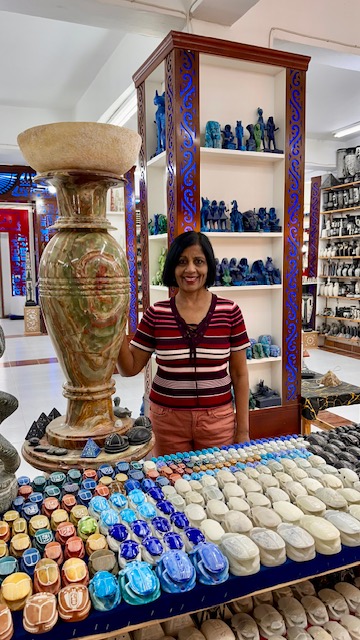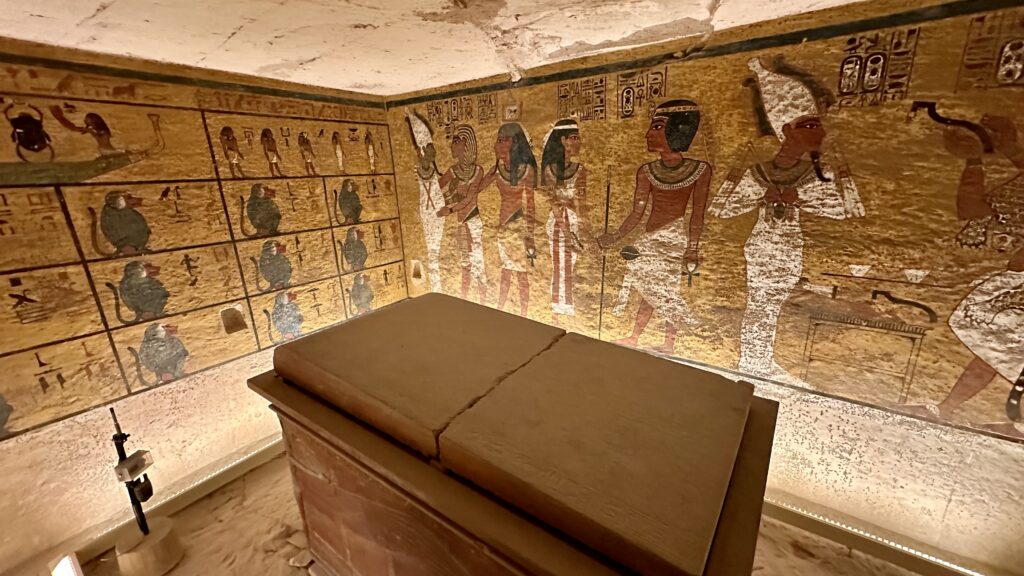We started our tour early this day, since we had a long list of sites to visit.
- Colossi of Memnon
- Mortuary temple of Queen Hatshepsut
- Granite shop
- Valley of Kings
Colossi of Memnon – The twin statues of Amenhotep III greet the visitors as we arrive on the West Bank. You can view them from the parking lot, or walk down to the statues for a closer view. Carved out of hard yellowish-brown sandstone quarried in the hills above Edfu, they represent Amenophis III seated on a cube-shaped throne, and once stood guard at the entrance to the king’s temple, of which only scanty traces are left. In Roman Imperial times, they were taken for statues of Memnon, son of Eos and Tithonus, who was killed by Achilles during the Trojan War.
The South Colossus is better preserved than the one to the north. It stands 19.59-meters high and the base is partly buried under the sand. With the crown that it originally wore but has long since vanished, the total height must have been some 21 meters. If you walk behind the statues, you can see the vast site (currently being excavated by archaeologists) where Amenophis III’s temple once sat.

Mortuary temple of Queen Hatshepsut – This temple is situated on the West Bank, at the foot of the desert hills, the light-colored sandstone of the temple standing out against the light brown rocks behind. Although built 3500 years ago, this temple feels more modern compared to the other Egyptian temples built during this time.

Cleopatra might be more famous, but Hatshepsut (Hat-shep-soot), born a royal princess during the New Kingdom period of Ancient Egypt, was the first historically documented woman to rule the powerful empire with the complete authority traditionally only given to men.

Hatshepsut was the eldest daughter of King Thutmose, and the wife of Pharaoh Thutmose II, her half-brother. Her father reigned only briefly, and upon his death, Hatshepsut became the queen-regent of her stepson and successor, Thutmose III, who, at the time, was considered too young to rule alone. However, in her seventh year as co-regent, Hatshepsut officially assumed the role of King of Upper and Lower Egypt and ruled for more than two decades. Once Hatshepsut took the throne, she reinvented herself and took a new royal name, Maatkare, meaning God of Truth.
She also opted for a complete gender transformation, depicting herself with a royal nemes headdress, short ritual shendyt-kilt and traditional false beard on her chin.
You can see her in the colorful relief on the left, offering incense to god.
The path up to the temple originally had 100 or so sphinxes bearing images of Hatshepsut’s head lined on both sides. There is one at the Egyptian Museum in Cairo. Among the impressive features of Hatshepsut’s temple are the colossal Osiride statues on the upper court. Hatshepsut is depicted as god Osiris. The Egyptians believed that a Pharaoh became Osiris at his death.



Alabaster factory – After our visit to Mortuary temple of Queen Hatshepsut, we stopped by an alabaster factory/shop nearby. Alabaster rocks come in 3 colors : White, Brown, and Green. Blocks of rocks are collected from the surrounding mountains on Luxor’s West Bank. The rocks are then cut and shaped to create beautiful objects that are displayed in the shop and sold world wide.





The Valley of the Kings is one of the most famous archaeological sites in the world. Located on the west bank of the Nile River near Luxor, this small area contains more than 60 exquisitely decorated tombs of Egypt’s ancient kings that include Tutankhamun, Ramses II, Tuthmosis III, and Seti I, as well as powerful nobles and the wives and children of the pharaohs. These tombs were constructed between 1539 and 1075 BC.
The tombs of Ramesses V/VI, and Tutankhamun are top 2 picks for some and I had to agree. We visited 5 tombs starting with Ramses III.
Tomb of Ramses III – Although the reliefs are not particularly well executed here, they are notable for their variety and the excellent preservation of the colors.




Tomb of Ramses V and VI – This tomb, originally begun for Ramses V, is notable for the excellent preservation of its painted sunk reliefs. Three corridors lead into an antechamber, beyond which is the first pillared chamber with which Ramses V’s tomb ended. On the left-hand walls, you can see scenes of the sun’s journey through the Underworld according to the Book of the Gates.




Tomb of Tutankhamun – Discovered in 1922, the Tomb of Tutankhamun is the most famous tomb in the Valley of the Kings. Tutankhamun was the son-in-law of Akhenaten, and died (in circumstances unknown) at the young age of 19. The tomb and its rich furnishings remained almost intact when it was discovered. These furnishings, including the gorgeous golden mask are on display in the Egyptian Museum in Cairo.
By the standard of other royal tombs, Tut’s is quite small, composed of four small rooms, only one of which is painted. Despite its size, however, the tomb was filled with everything the pharaoh would need for the afterlife, including furniture, chariots, wine, fresh food, clothing, shaving and writing equipment, musical instruments, games, and weapons. There were four gold shrines, one fitted inside the other, within which were nested quartzite, wooden, and golden sarcophagi. The innermost sarcophagus contained the pharaoh’s mummy wearing a 24-pound solid gold mask.
Tutankhamun’s mummy and sarcophagus are still on display in the tomb.

Tomb of Merenptah – King Merenptah was the 11th son of King Ramses II. He was an 60 years old when he ascended the throne, after the long rule of his father. He ruled for only about ten years, but his tomb was completed before his death. The Tomb of Merenptah is the second largest one in the Valley of the Kings. Although the decorations in the tomb were damaged by floods, the paint still shows traces of fine, bright blue-green, yellow, and red pigments.



Tomb of Ramses IV – The tomb’s architecture and art are exemplary of the period’s style, featuring vibrant wall paintings and inscriptions from religious texts. These artistic elements provide insights into the beliefs and funerary rituals of ancient Egypt. An ancient staircase with a ramp in the middle leads to the entrance of this tomb. On the right-hand entrance wall, you can see two figures of Copts raising their hands in prayer. In the main chamber is the pharaoh’s granite sarcophagus covered with inscriptions and reliefs.
Relaxing afternoon on the cruise ship – After visiting Valley of Kings, we came back to the ship and had a relaxing day on the deck watching towns go by or taking a nap.


Vendors in small boats trying to sell their textiles to people on cruise ships. When there is interest, they fling the textiles up to the passengers. The vendors and passengers bargain by shouting back and forth and if a sale is made, the buyers throw the money down to salesmen in a bag.
The cruise ship passed through the Lock of Esna late evening. The lock serves as a “water elevator” that allows Nile cruise boats to navigate the 10-meter difference in altitude during their journey. The lock’s structure also functions as a bridge between the two banks of the Nile.






